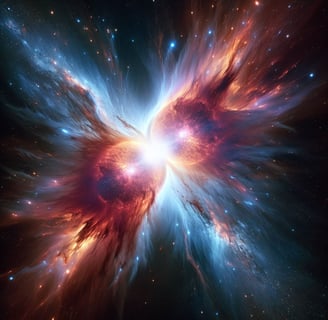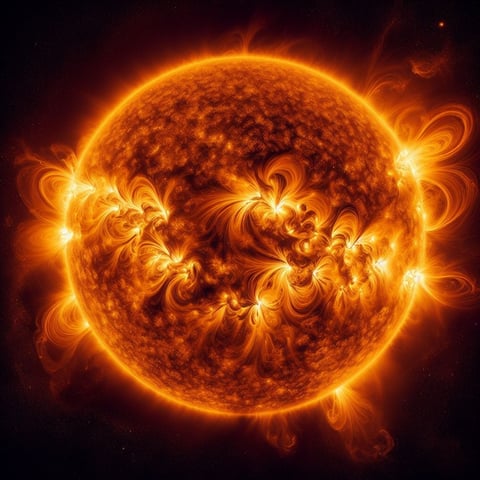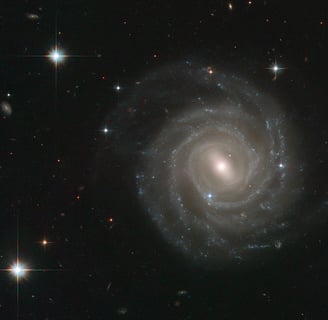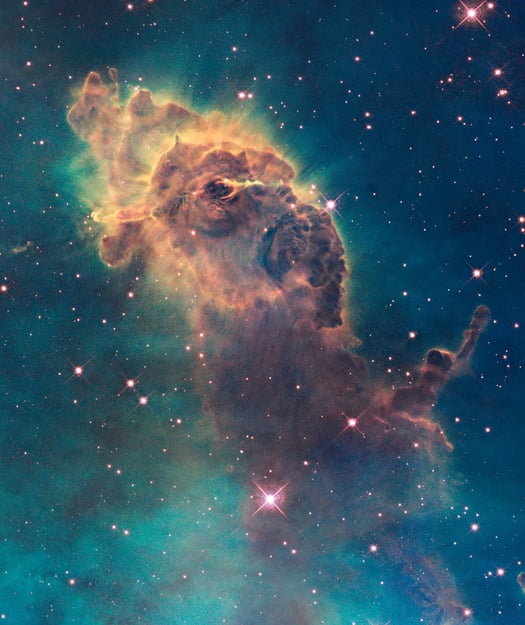star-crossed supernovas: what happens when stars collide
Explore the breath-taking aftermath of stellar collisions in 'Star-Crossed Supernovas: What Happens When Stars Collide.' Understand the science behind these rare and spectacular events.
SCIENCESTARS
5/18/20247 min read


What happens when one star collides with another? Galactic fireworks? A nuclear explosion? Does it create a black hole?
Not sure?
if not, keep reading to find out!
First of all, what exactly is a star?
A star is a luminous sphere of plasma held together by its own gravity. Plasma is superheated matter, so hot that electrons are ripped away from their atoms to create an ionized gas.
Matter is anything that has mass and takes up space - it's what makes up everything around us, from the air we breathe to the food we eat and the stars in the sky. The superheated matter that makes up the mass of a star - plasma - is composed mostly of hydrogen and helium, both ionized gasses, as well as traces of other elements.
Earth’s own Sun is indeed a star. In fact, it's the closest star to Earth and the center of our solar system. Like other stars, the Sun is a huge (to put it lightly) glowing sphere of hot gas (plasma, primarily composed of hydrogen and helium) undergoing nuclear fusion reactions in its core. These fusion reactions generate the Sun's energy and light, which radiates out into space, providing heat and light to the planets orbiting around it.
Stars are the fundamental building blocks of galaxies, and they play a central role in the structure and evolution of the universe. The Sun's immense gravitational pull holds the solar system together and governs the orbits of the planets, moons, asteroids, and comets within it.
Okay, and why are stars so important?
Energy Source: Stars are the primary sources of light, heat, and energy in the universe. They provide the necessary conditions for life to exist on planets within their habitable zones. Without the Sun, life would not be able to exist on Earth.
Elemental Production: Nuclear fusion processes in stars produce heavier elements beyond hydrogen and helium, such as carbon, oxygen, and iron. These elements are essential for the formation of planets, moons, and life itself.
Galactic Dynamics: Stars play a crucial role in the dynamics of galaxies, influencing their structure, evolution, and interactions. Their gravitational pull shapes the distribution of matter within galaxies and contributes to the formation of galactic structures such as spiral arms and star clusters.
Cosmological Significance: Studying stars allows scientists to probe the fundamental properties of matter, energy, and the universe's evolution. Observations of stars at different stages of their life cycles provide insights into stellar evolution, galactic dynamics, and the history of the cosmos.
So, what happens during a star’s life cycle?
Stars don’t last forever because they eventually run out of the fuel that powers them, meaning the life cycle of a star depends on its mass. Here's a simplified explanation of the life cycle of a star like our Sun:
Birth (Formation): Stars form from dense regions of gas and dust called molecular clouds or nebulas. Gravity causes these clouds to collapse, forming a protostar—a hot, dense core surrounded by a rotating disk of gas and dust.
Main Sequence (Adult Stage): Once the temperature and pressure at the core of the protostar become high enough, nuclear fusion reactions begin, converting hydrogen into helium. This stage, known as the main sequence, is the longest phase in a star's life cycle. Our Sun is currently in this stage.
Red Giant (Late Stage): As a main sequence star like the Sun exhausts its hydrogen fuel, the core contracts and heats up while the outer layers expand, causing the star to swell into a red giant. During this phase, heavier elements may be formed through fusion reactions in the star's core.
Planetary Nebula or Supernova (End Stage):
Low to medium mass stars (like the Sun): After the red giant phase, the outer layers of the star are expelled into space, forming a colorful cloud of gas and dust called a planetary nebula. The remaining core, known as a white dwarf, gradually cools over billions of years.
High mass stars: Stars with more mass undergo a more dramatic end stage. They may explode in a catastrophic event called a supernova, where the outer layers are ejected into space, leaving behind a dense core. Depending on the mass of the core, it may become a neutron star or collapse further to form a black hole.
Remnants: After the end stage, the remnants of the star (such as white dwarfs, neutron stars, or black holes) continue to cool or evolve, eventually fading away over astronomical timescales.
This is a general overview of the life cycle of a star like our Sun, but stars of different masses may follow slightly different paths.
How long exactly do stars live?
The lifespan of a star varies depending on its mass. Generally, more massive stars burn through their fuel more quickly and have shorter lifespans, while less massive stars have longer lifespans. Here are approximate lifespans for stars of different masses:
Low-Mass Stars (0.1 to 0.5 times the mass of the Sun): These stars have the longest lifespans, ranging from tens of billions to trillions of years. They burn their fuel very slowly and may remain on the main sequence for tens of billions of years before becoming red giants and eventually cooling as white dwarfs.
Intermediate-Mass Stars (0.5 to 8 times the mass of the Sun): These stars have shorter lifespans, typically ranging from a few million to a few billion years. They burn their fuel at a moderate rate and may spend a few billion years on the main sequence before becoming red giants and eventually forming planetary nebulae or undergoing supernova explosions.
High-Mass Stars (more than 8 times the mass of the Sun): These stars have the shortest lifespans, typically ranging from a few million to a few tens of millions of years. They burn their fuel very rapidly and may spend only a few million years on the main sequence before ending their lives in supernova explosions, leaving behind remnants such as neutron stars or black holes.
It's important to note that these are approximate lifespans and can vary depending on factors such as the star's composition and environment. Additionally, the concept of stellar evolution and life spans is based on our current understanding of astrophysics and may be refined as new observations and theories emerge.
So, do stars collide?
Yes, stars can collide through various mechanisms, but one of the most common scenarios involves binary star systems, where two stars orbit around a common center of mass due to their gravitational attraction to each other. Here's an overview of how stars can collide, and what happens when they do:
Binary Star Evolution: In a binary star system, the evolution of both stars can lead to a collision if one of the stars undergoes significant expansion or mass loss. For example, a star in a binary system may evolve into a red giant, expanding its outer layers and encroaching upon its companion star's space.
Three-Body Interactions: In some cases, gravitational interactions within a cluster of stars can result in a close encounter between two stars, leading to their eventual collision. This scenario is more common in dense stellar environments such as globular clusters, where gravitational interactions between multiple stars play a significant role.
Galactic Collisions: In rare cases, entire galaxies can undergo mergers, bringing their constituent stars into close proximity. As galaxies merge, gravitational interactions between stars can result in collisions and mergers on a galactic scale, leading to the formation of new stars and the restructuring of entire galaxies.
What happens when stars collide?
Stellar Merger: When two stars collide, their outer layers may be stripped away, exposing their hot, dense cores. Depending on the masses and sizes of the colliding stars, the merger can result in the formation of a single, more massive star with a different chemical composition than either of the original stars.
Supernova Explosion: In some cases, the collision of two stars can trigger a supernova explosion, releasing an immense amount of energy and ejecting stellar material into space. This phenomenon, known as a type Ia supernova, occurs when a white dwarf star accretes material from a companion star until it reaches a critical mass, leading to a runaway nuclear fusion reaction.
Formation of Exotic Objects: Stellar collisions can also give rise to exotic objects such as neutron stars or black holes. When the cores of two massive stars merge, the resulting object may exceed the Chandrasekhar limit (about 1.4 times the mass of the Sun), leading to the collapse into a neutron star or black hole, depending on the mass of the remnant.
Impact on Surrounding Space: Stellar collisions can have significant implications for their surrounding environments. The energy released during a collision can heat up and ionize nearby gas and dust clouds, triggering the formation of new stars and influencing the dynamics of the surrounding interstellar medium.
Overall, star collisions are rare but powerful events that can have profound effects on the evolution of galaxies and the formation of exotic astronomical objects. Studying these collisions provides valuable insights into the dynamics of stellar systems and the processes that shape the universe.
If you want to know more about the origins of our universe, try reading these:












